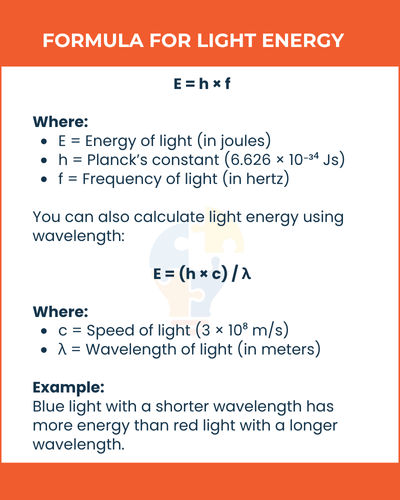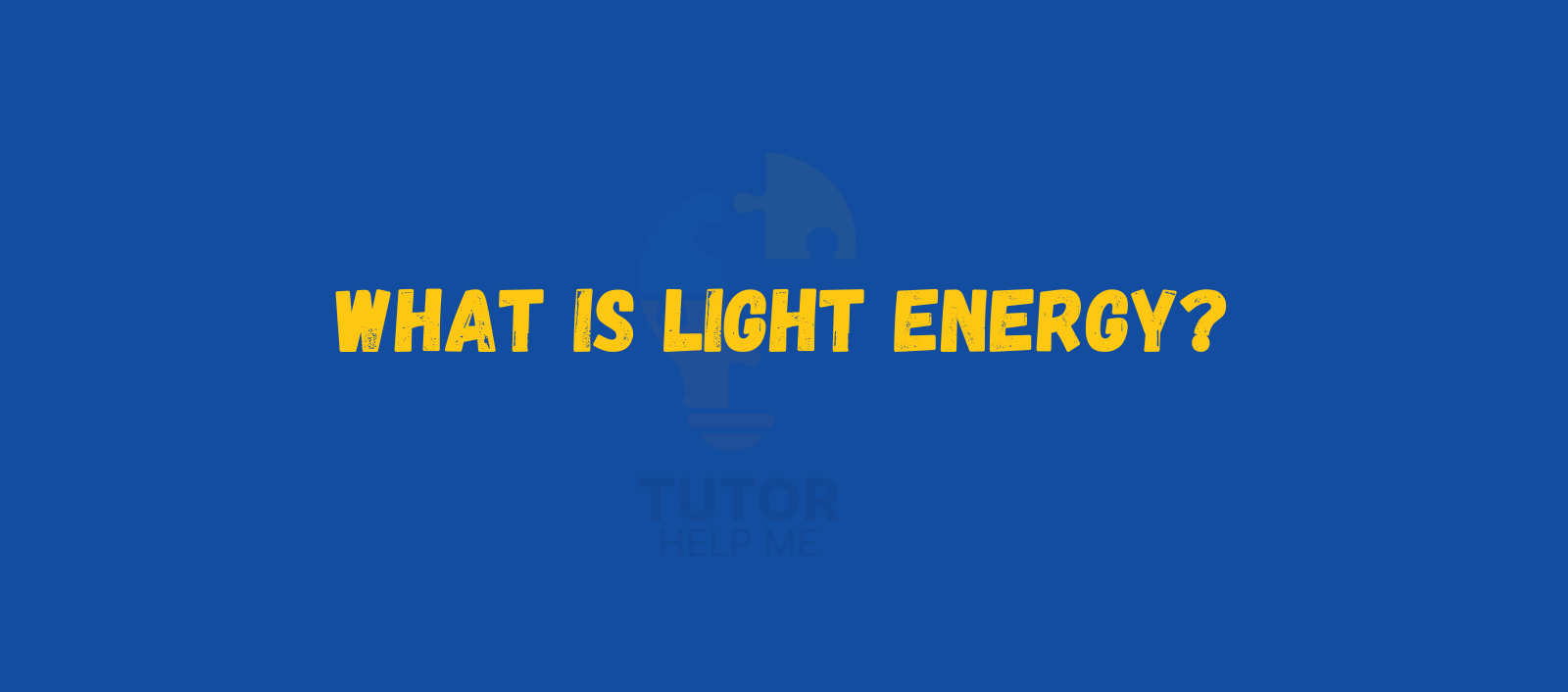Have you ever wondered how you see things around you? From sunlight brightening the sky to a lamp lighting up your room, it all happens because of light energy.
Light energy is one of the most important forms of energy in our daily lives. It helps plants grow, supports life on Earth, and powers many modern technologies.
In this blog, you’ll learn what is light energy, its formula, spectrum, properties, functions, and real-life examples. Let’s explore how light brings the world to life!
What Is Light Energy?
Light energy is a form of energy that travels in waves and can be seen by the human eye. It is also called radiant energy because it spreads out from a source, like the sun or a bulb.
Example:
Sunlight, candlelight, and light from a torch are all examples of light energy.
Light energy can move through empty space, unlike sound or heat. This is why sunlight reaches Earth even though space has no air.
Light Energy Equation and Formula
The formula for light energy comes from the relationship between energy, frequency, and wavelength.
E = h × f
Where:
- E = Energy of light (in joules)
- h = Planck’s constant (6.626 × 10⁻³⁴ Js)
- f = Frequency of light (in hertz)
You can also calculate light energy using wavelength:
E = (h × c) / λ
Where:
- c = Speed of light (3 × 10⁸ m/s)
- λ = Wavelength of light (in meters)
Example:
Blue light with a shorter wavelength has more energy than red light with a longer wavelength.

The Light Energy Spectrum
Light energy is part of a wider group called the electromagnetic spectrum. This spectrum includes all types of electromagnetic waves, from long radio waves to short gamma rays.
Parts of the electromagnetic spectrum:
- Radio waves
- Microwaves
- Infrared rays
- Visible light (what our eyes see)
- Ultraviolet rays
- X-rays
- Gamma rays
Visible light spectrum (ROYGBIV):
Red, Orange, Yellow, Green, Blue, Indigo, Violet
Each color has a different wavelength.
- Red has the longest wavelength.
- Violet has the shortest wavelength and highest energy.
Uses of Light Energy
Light energy has many uses in our daily lives, science, and technology.
Food
Light energy from the sun helps plants make food through photosynthesis. Without sunlight, plants cannot grow or produce oxygen.
Example:
Green plants use sunlight to make sugar and release oxygen, which supports all living things.
Vision
Light enables us to see objects. When light reflects off a surface and enters our eyes, our brain processes it into images.
Example,
Without light, everything would appear dark.
Colours
Light helps us see different colors. The color we see is determined by the wavelengths that are reflected back to our eyes. For example, a red apple appears red because its surface absorbs all colors except red, which it reflects.
When white light passes through a prism, it splits into seven colors red, orange, yellow, green, blue, indigo, and violet.
Example:
A rainbow is a natural result of sunlight refracting through water droplets.
Properties of Light Energy
Light energy has several unique properties that make it different from other energy forms.
Electromagnetic Radiation
Light energy is a type of electromagnetic radiation that travels in the form of waves. It does not need air or any medium to move.
Example:
Sunlight travels through the vacuum of space to reach Earth.
Wave-Particle Duality
Light behaves both like a wave and a particle (called a photon).
- As a wave, it travels through space and causes phenomena like reflection and refraction.
- As a particle, it transfers energy when it hits objects.
Example:
Solar panels absorb light photons and convert them into electricity.
Travels at a Constant Speed
Light always travels at the same speed in a vacuum: 3 × 10⁸ meters per second (300,000 km/s).
Example:
Light from the sun takes about 8 minutes to reach Earth, even though the sun is 150 million kilometers away.
Can Be Absorbed
Light energy can be absorbed by different surfaces. Dark surfaces absorb more light and convert it into heat, while shiny surfaces reflect it.
Example:
A black car becomes hotter in the sun compared to a white one.
Functions and Importance of Light Energy
Light energy plays many essential roles in nature and technology.
Vision
Light makes sight possible. Our eyes capture light reflected from objects, allowing us to see their shape, color, and brightness. Without light, we wouldn’t be able to see or identify anything around us.
Photosynthesis
Light energy is crucial for photosynthesis, the process by which plants produce food.
Process:
- Plants absorb sunlight through chlorophyll.
- They convert water and carbon dioxide into glucose and oxygen.
Learn more about What is Photosynthesis? Process, Importance, and Factors Explained
Equation:
6CO₂ + 6H₂O → C₆H₁₂O₆ + 6O₂
Example:
Sunlight helps plants grow and provide oxygen for humans and animals.
Heat and Warmth
Light energy provides heat and warmth. When light hits a surface, it raises its temperature.
Example:
Standing in sunlight feels warm because light energy converts to heat.
This property keeps the Earth’s climate suitable for life.
Technology
Light energy is used in many modern devices and inventions.
Examples:
- Lasers in medicine and engineering
- Optical fibers for high-speed internet
- Solar panels to generate electricity
- Cameras and telescopes to capture images
Light energy has transformed how we communicate, travel, and live.
Reflection and Refraction
Light changes direction when it hits surfaces.
- Reflection: When light bounces off a surface.
- Refraction: When light bends as it passes through materials.
Example:
- A mirror shows reflection.
- A straw in water looks bent due to refraction.
10 Examples of Light Energy
Here are real-life examples that show how light energy works around us:
- Sunlight – The main natural source of light and warmth.
- Fire – Produces both heat and light.
- Light bulbs – Convert electricity into visible light.
- Lasers – Concentrated light used in surgeries and scanners.
- Candle flame – Chemical reaction releases light energy.
- Lightning – Electrical energy in clouds producing bright flashes.
- Neon lights – Gas emits light when electricity passes through it.
- LED lamps – Energy-efficient light sources.
- TV and phone screens – Emit visible light for images.
- Stars – Natural sources of light energy across the universe.
Light Energy in Nature
Nature uses light in many wonderful ways:
- Rainbows: Created when sunlight refracts through raindrops.
- Aurora lights: Produced when solar particles collide with Earth’s magnetic field.
- Bioluminescence: Some organisms like fireflies produce light naturally.
Difference Between Light Energy and Heat Energy
| Feature | Light Energy | Heat Energy |
|---|---|---|
| Definition | Energy that makes objects visible | Energy that raises temperature |
| Form | Electromagnetic radiation | Kinetic energy of particles |
| Travel | Through vacuum | Through solids, liquids, gases, vacuum |
| Example | Sunlight, bulb | Stove, heater |
Fun Facts About Light Energy
- Light from the sun takes about 8 minutes and 20 seconds to reach Earth.
- Light can travel around the Earth 7.5 times in one second.
- The human eye can see only a small part of the electromagnetic spectrum.
- Laser stands for “Light Amplification by Stimulated Emission of Radiation.”
- A rainbow shows the visible light spectrum naturally.
Conclusion
Light energy is one of the most vital forms of energy in the universe. It helps plants grow, allows us to see, and keeps the planet warm.
Whether it’s the sun shining on Earth or a bulb lighting a room, light energy makes life possible.
By understanding what is light energy, its properties, and importance, we can appreciate how deeply it affects our daily lives and the world around us.
From natural sunlight to modern technology, light truly powers life on Earth.
Read More What is Thermal Energy?
FAQs
Q1: What is light energy in simple words?
A: Light energy is the energy that helps us see and travels in waves from sources like the sun or bulbs.
Q2: What type of energy is light energy?
A: It is a form of electromagnetic energy.
Q3: How is light energy produced?
A: It is produced when atoms release photons, like in the sun, fire, or lamps.
Q4: Can light travel through space?
A: Yes, light can move through a vacuum, unlike sound.
Q5: What are the properties of light energy?
A: It travels in waves, moves fast, reflects, refracts, and can be absorbed.
Q6: What is the formula for light energy?
A: E = h × f, where h is Planck’s constant and f is frequency.
Q7: Why is light energy important?
A: It helps plants make food, allows us to see, and powers technology.
Q8: What are the sources of light energy?
A: The sun, bulbs, candles, and stars are common sources.
Q9: Is light a wave or particle?
A: Both, it shows wave-particle duality.
Q10: How fast does light travel?
A: 3 × 10⁸ meters per second (300,000 km/s).
Q11: What is visible light?
A: The part of the electromagnetic spectrum that humans can see.
Q12: What are natural sources of light?
A: Sun, fire, and bioluminescent animals.
Q13: What are artificial sources of light?
A: Bulbs, LEDs, and torches.
Q14: Does light have mass?
A: No, light has no mass but carries energy.
Q15: What is reflection of light?
A: When light bounces off a surface like a mirror.
Q16: What is refraction of light?
A: When light bends while passing through materials like glass or water.
Q17: Can light be stored?
A: Not directly, but it can be converted to electricity and stored in batteries.
Q18: What is the wavelength of visible light?
A: Between 380 nm and 700 nm.
Q19: What color of light has the most energy?
A: Violet has the most energy.
Q20: How is light used in technology?
A: In lasers, solar panels, communication, and medical equipment.

